At SpeedX Marketing, we are a leading provider of innovative IT solutions tailored to meet your specific business needs. With years of expertise and a team of skilled professionals, we offer cutting-edge technology solutions that drive growth and efficiency.
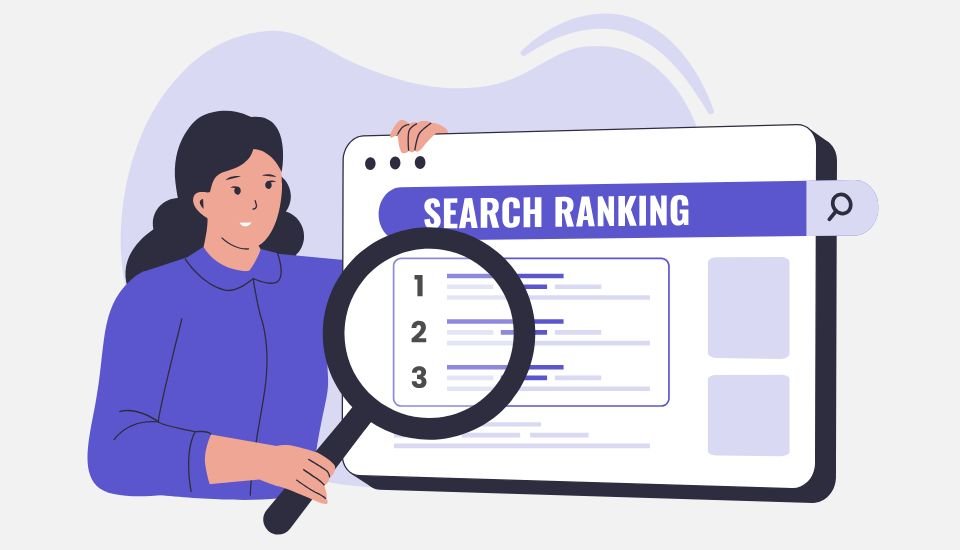
A website’s position in search engine results pages (SERPs) plays a pivotal role in its visibility and overall success. “Website ranking” refers to the placement a site achieves when users search for keywords or phrases relevant to its content on platforms like Google, Bing, or Yahoo. This placement directly affects how easily potential visitors can discover the site, making it a fundamental aspect of search engine optimization (SEO) and digital marketing strategies. For website owners, marketers, and SEO professionals, knowing how to evaluate and improve these rankings is key to boosting online visibility and attracting more organic traffic. This guide delves into the importance of website ranking, explains why it matters, and offers insights into tools and techniques to monitor and enhance rankings effectively.
Understanding website ranking is crucial for any digital strategy as it directly impacts how visible a website is to potential visitors. Simply put, website ranking denotes the specific position that a website occupies on the search engine results pages (SERPs) when users search for particular keywords or phrases associated with the website’s content. These rankings are not static; they are dynamic and can fluctuate based on a multitude of factors. Some of these factors include the effectiveness of a website’s SEO strategies, any changes to search engine algorithms, and the competitive actions of other websites within the same niche or industry.
Importantly, it’s essential to recognize that different types of websites may be subjected to different ranking criteria. For instance, ecommerce sites, local service providers, informational blogs, and corporate websites might all be evaluated and ranked according to varying priorities and algorithms. Search engines tailor their criteria based on the type of content, the expected user intent, and the overall user experience offered by the website. For example, for local service providers, proximity to the searcher may play a significant role, whereas for an ecommerce site, factors like user reviews, product descriptions, and availability might have more weight. Understanding these nuances is key to optimizing any website according to its specific needs and the expectations of its intended audience.
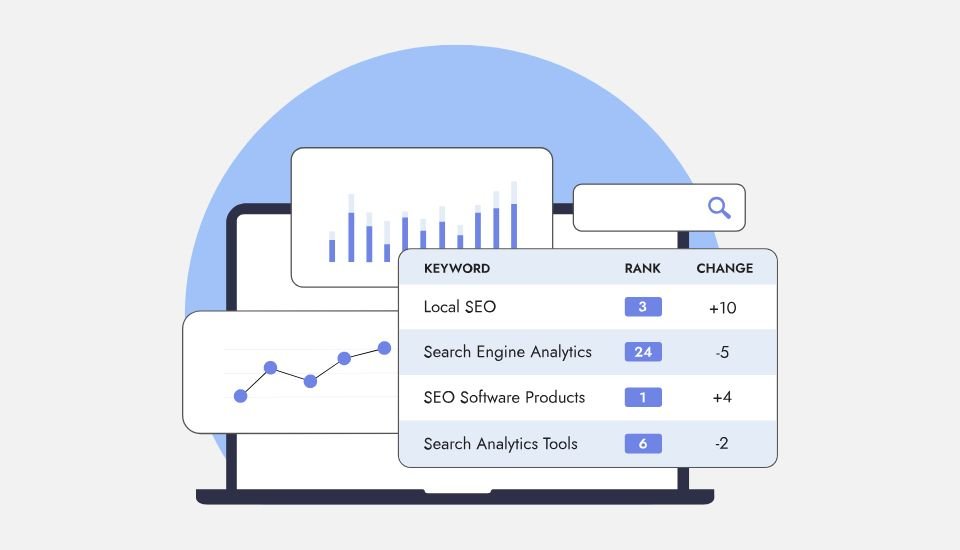
Understanding your website’s ranking on search engine results pages (SERPs) goes beyond mere curiosity about your position; it’s a strategic effort that plays a pivotal role in optimizing your online presence. Here’s why checking your website ranking is crucial:
Checking your rankings helps you identify which keywords and phrases are most effective at driving traffic to your site. By understanding what search terms lead users to your pages, you can uncover new keyword opportunities or optimize existing content to better meet your audience’s needs. This isn’t just about finding high-volume keywords but also discovering niche terms that can bring in more targeted, valuable traffic.
Regularly tracking your website’s rankings allows you to see how your SEO efforts are performing over time. It serves as a benchmark for your optimization strategies. By monitoring these rankings, you can quickly identify which changes to your website (such as new content, technical improvements, or on-page optimizations) have had a positive impact, and which may have not worked as expected. This ongoing evaluation helps you refine your SEO tactics, ensuring they effectively contribute to improving your SERP positions.
Understanding where you stand in comparison to your competitors is a key aspect of SEO and business strategy. By checking your website’s ranking, you can gain insights into not just your own site’s performance but also how well you are doing relative to your market competitors. This analysis can reveal strengths to build upon and weaknesses that need attention, providing a clear direction for strategic improvements. It also helps in identifying what competitors are doing differently or better, which can inspire changes to your approach.
The performance of your content on search engines provides critical feedback for your content strategy. By knowing which pieces of content rank well, you can analyze what makes them successful and apply these findings to other areas of your site. Conversely, identifying content that isn’t performing well can help you make decisions about updates or whether to change focus. Aligning your content strategy with what resonates best with your audience and what is most visible on search engines ensures that your efforts yield maximum engagement and conversion.
Checking your website ranking is an essential practice for any digital marketer, SEO professional, or business owner looking to succeed online. It’s not just about tracking positions but understanding the broader context of those rankings — what drives them, how they compare with competitors, and how they can inform your broader marketing and content strategies. By effectively analyzing this data, you can make informed decisions that enhance your online visibility, attract more traffic, and ultimately drive greater business success.
Checking your website’s ranking can provide valuable insights into the effectiveness of your SEO strategy, the quality of your content, and your overall online visibility. Here’s how you can check your website ranking:

Manual searching is one of the simplest and most straightforward methods to check your website’s ranking. It involves two primary approaches: Basic Search and Incognito Mode. Each has its benefits and limitations, which we will explore in detail.
In this method, you directly use a search engine to input your target keywords and then scroll through the search engine results pages (SERPs) to locate your website. This approach gives you a quick sense of where your site stands in terms of visibility for specific keywords. However, the accuracy of this method can be compromised by several factors:
Personalization: Search engines like Google tailor search results based on the user’s previous browsing history, location, device, and even social settings. This means the results you see might not be the same as what others see, even when searching for the same terms.
Geolocation: Your physical location can greatly influence the search results. For instance, a search for “coffee shops” will yield vastly different results in New York City compared to Tokyo.
Despite its limitations, the basic approach provides a quick check that can help gauge your website’s immediate search engine visibility to some extent.
To overcome the challenges posed by personalized search results, you can use your browser’s incognito or private browsing mode. When you perform a search in this mode, the browser does not use your past browsing history or data to influence search results, providing a more neutral perspective. Here’s how it improves the manual search:
Reduced Personalization: Incognito mode minimizes the influence of your localized data and personal search history, offering a cleaner slate for search queries.
More General Results: This mode is particularly useful for assessing how well your site performs in search engines for users who are not already associated with your site through cookies or cached data.
To use incognito mode, simply open your browser and look for the option to open a new incognito or private window (this varies by browser but is generally found in the menu in the upper right corner). Once the window is open, conduct your searches from there.
While manual search methods provide immediate insights, they lack the comprehensive detail and ongoing tracking capabilities provided by more advanced SEO tools and software. However, they serve as a good starting point for a basic understanding of your website’s visibility in search engines.
For those looking to delve deeper into website performance and obtain precise data on search rankings, SEO tools and software offer sophisticated solutions. These tools not only automate the tracking of your website’s position in search engine results but also provide a wealth of insights that can help refine your SEO strategy. They analyze a broad spectrum of SEO metrics, such as keyword rankings, backlink profiles, and competitor analysis, equipping you with the necessary information to make informed decisions. By leveraging these advanced tools, marketers and SEO professionals can save time, increase accuracy, and effectively enhance their website’s visibility and performance across various search engines. Let’s explore some of the most popular and powerful SEO tools and software available in the market.
Google Search Console (GSC) is a free service offered by Google that is indispensable for anyone managing a website, particularly for monitoring and enhancing its presence in Google search results. This tool provides a wealth of data about your site’s performance, offering critical insights that can help you optimize your search engine strategy.
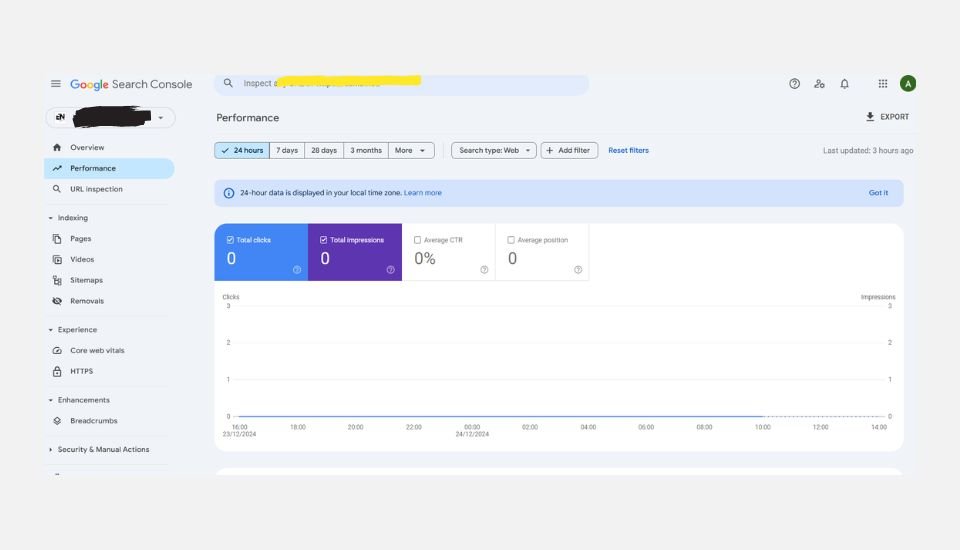
GSC provides detailed reports on how your site performs in Google Search. The performance report includes data on:
To use Google Search Console, you need to verify ownership of your website, which can be done through several methods such as HTML file upload, domain name provider, HTML tag, Google Analytics, or Google Tag Manager. Once verified, Google begins tracking data for your site, which you can view anytime.
SEMrush is a robust SEO and digital marketing tool that serves as an indispensable resource for businesses aiming to optimize their online presence. Recognized for its comprehensive capabilities, SEMrush provides users with an extensive array of features that help track website ranking, conduct competitive analysis, and execute multifaceted marketing strategies. Here’s a detailed look at how SEMrush functions and why it’s highly valued by digital marketers.
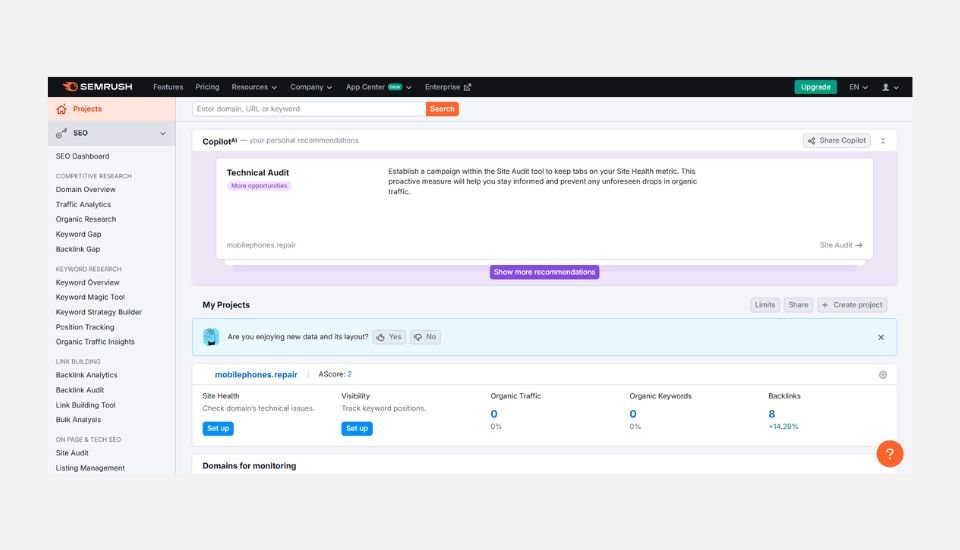
To begin using SEMrush, you can sign up for a free trial, which gives you limited access to its features. For full access, various subscription plans are available, tailored to different needs and budgets. Once registered, you can immediately start entering your domain or the domains of your competitors to gather insights and begin formulating or adjusting your digital marketing strategies.
Ahrefs is a robust SEO toolkit that is renowned in the digital marketing world primarily for its exceptional backlink analysis capabilities. However, Ahrefs also provides a suite of tools for rank tracking, which allows users to monitor their website rankings over time and compare their performance against competitors. This multifaceted platform is instrumental for marketers, SEO professionals, and website owners aiming to strengthen their online presence and enhance their search engine optimization strategies.

Getting started with Ahrefs for backlink analysis and rank tracking involves setting up an account and adding your project (website). Once your website is added, you will need to specify the target keywords you wish to track. Ahrefs will begin collecting data, providing insights into your SERP standings, and tracking changes as they happen.
Moz Pro is an all encompassing SEO software suite designed to assist marketers, website owners, and SEO professionals in enhancing their online visibility and search engine performance. One of the standout features within Moz Pro is the Rank Tracker, which provides robust functionalities to monitor and analyze search engine rankings for specific keywords. Here’s a detailed look at how Moz Pro, particularly its Rank Tracker, serves as a vital tool for SEO management.
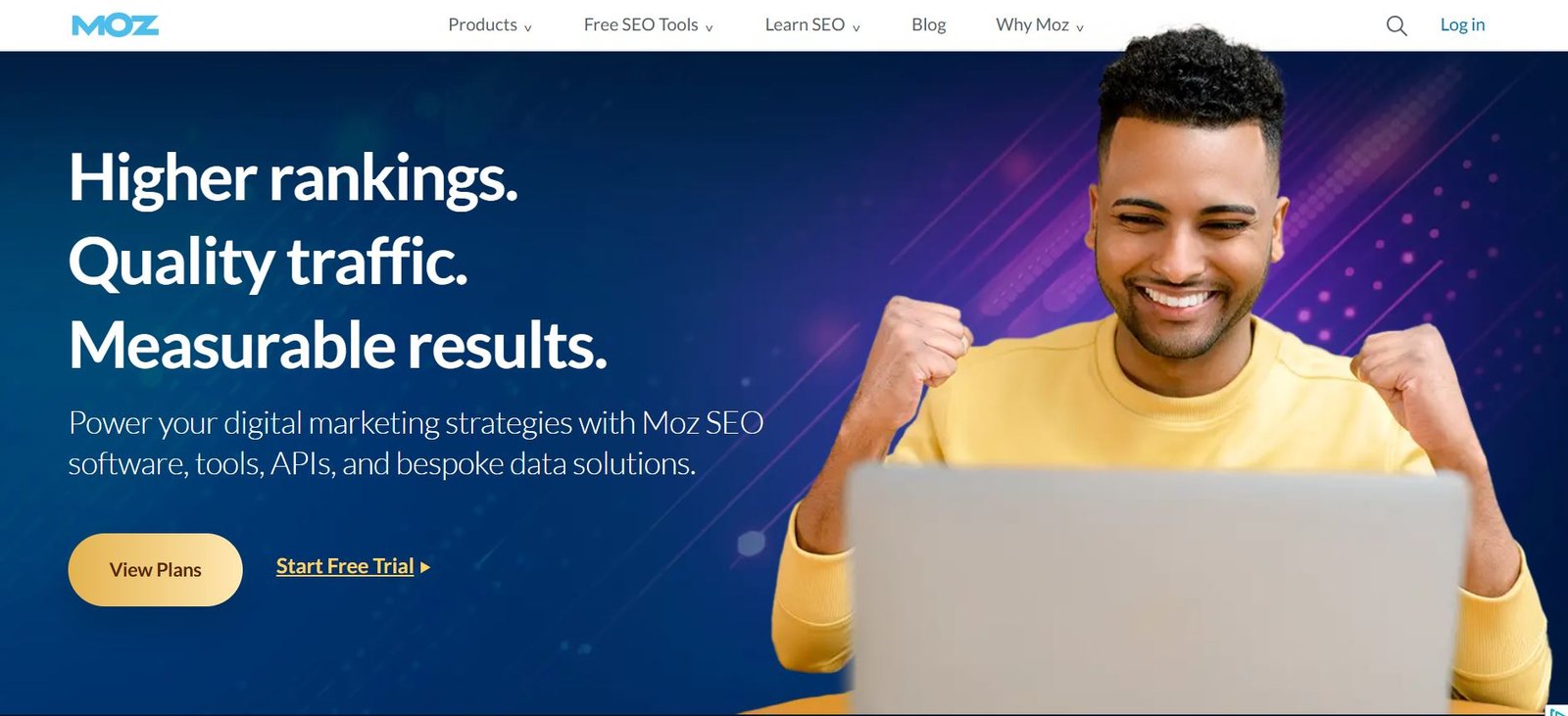
To use Moz Pro, including the Rank Tracker, you typically start with a free trial, which allows you to test the functionalities and see if they fit your needs. Posttrial, various subscription plans are available that cater to different levels of usage and feature access, depending on the size and scope of your SEO efforts.
Ubersuggest is a versatile SEO tool designed by Neil Patel, which offers a comprehensive suite of functionalities to help website owners and digital marketers optimize their online presence. One of its core features is providing users with detailed insights into their website rankings for specific keywords across various search engines. Here’s a detailed look at how you can determine your website’s ranking using Ubersuggest.
Keyword Tracking: Ubersuggest allows users to track specific keywords to see how well their website ranks for those terms over time. This feature is particularly useful for monitoring the effectiveness of your SEO strategies and understanding how different keywords perform in driving traffic to your site. The tool provides data on keyword volume, competition, CPC, and seasonal trends, helping you to optimize your content strategy effectively.
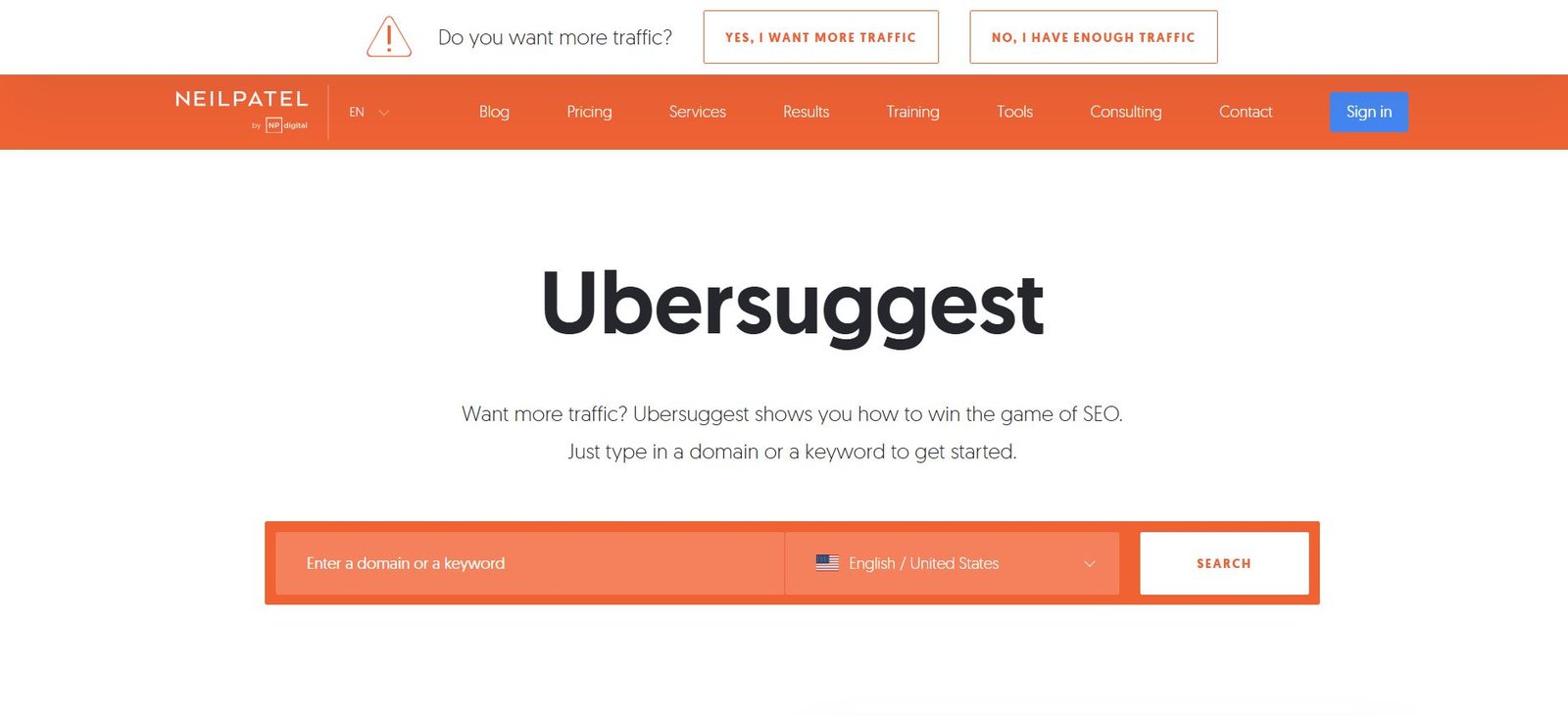
SEO Analyzer: The SEO Analyzer tool offers a comprehensive analysis of your website’s overall SEO health. It checks for on page optimization issues, such as poor meta descriptions, improper use of headings, and slow loading times, which can affect your website rankings.
It also provides a detailed list of backlinks, assessing the quality and quantity of links pointing to your site, which is a crucial factor in search engine rankings.
First, you’ll need to create an account on Ubersuggest or log in if you already have one. Once logged in, enter your website’s domain into the search bar. Ubersuggest will analyze your domain and pull up an overview of its SEO metrics. Go to the ‘Keywords’ section to see a list of all the keywords your site is currently ranking for, along with their positions in the SERPs, search volume, and other relevant metrics. You can set up tracking for specific keywords to monitor your rankings over time. This allows you to see how your rankings fluctuate and how well your SEO efforts are performing.
Third Party rank checking services offer valuable insights into your website’s performance across different search engines and geographic locations. These tools are essential for SEO professionals, marketers, and business owners who want to closely monitor and improve their site’s search engine rankings. While popular names like SEMrush, Ahrefs, Moz, and Ubersuggest are often discussed, there are other significant tools in the market that provide robust rank checking capabilities.
Serpstat is a comprehensive SEO platform that offers various features including keyword research, SERP analysis, backlink analysis, and rank tracking. It is particularly known for its competitive analysis capabilities. It provides detailed reports on SEO, PPC, search analytics, and content marketing. The rank tracker tool updates daily and allows tracking of your website’s position for targeted keywords across different regions and devices. Serpstat offers various pricing plans catering to different needs, from individual users to large enterprises.
SpyFu is primarily known for its competitor analysis tools but also offers detailed SEO rank tracking. It allows users to track keyword rankings and their historical performance. Additionally, SpyFu can show you every keyword your competitors have bought on Google Ads, every organic rank, and every ad variation in the last 14 years. SpyFu provides different subscription levels, suitable for both small businesses and large agencies.
Majestic specializes in backlinks analysis but its tools also help in tracking how these links influence your website’s ranking. Known for its large index of URLs, Majestic offers detailed insights into how backlinks correlate with rankings. It provides metrics like Trust Flow and Citation Flow, which help gauge the quality and quantity of links. Majestic offers several plans that range from entry level options for starters to more advanced features for SEO experts and large teams.
AWR is a tool used by thousands of SEOs for its accurate rank tracking and robust reporting capabilities. It offers global and local rank tracking updates on demand or at scheduled intervals, competitive insights, and reports that can be customized and white labeled. AWR supports desktop, mobile, and local searches across different search engines. Pricing is flexible, based on the frequency of ranking updates and the number of keywords tracked, making it suitable for both small businesses and large enterprises.
AccuRanker is renowned for its speed and accuracy in rank tracking. This tool offers daily keyword updates and ondemand updates, providing instant data on rankings. It also integrates with other platforms like Google Analytics, Google Search Console, and major social media for a comprehensive overview of your digital marketing performance. AccuRanker’s pricing is based on the number of keywords tracked, catering to both agencies and in house marketers.
These third party rank checking services offer a range of options outside the mainstream tools, each with unique features that cater to different SEO needs and budgets. By utilizing these tools, businesses can gain deeper insights into their search engine rankings, understand competitive landscapes, and strategically enhance their online visibility. Choosing the right tool often depends on your specific requirements such as budget, size of the keyword set, frequency of reporting, and the particular nuances of your SEO campaign.
Regularly monitoring your website’s ranking is an indispensable component of successful search engine optimization (SEO). This practice not only measures the efficacy of your SEO initiatives but also provides critical insights that inform strategic decisions, ultimately enhancing your online visibility and increasing website traffic. The dynamic nature of search engine algorithms and the competitive online environment necessitates a proactive approach in tracking and responding to your website’s SERP positions. By utilizing robust tools and adopting proven methodologies for analyzing website rankings, you can not only achieve but sustain a strong presence in search results. This ongoing vigilance and adaptation ensure that your site remains relevant and visible to your target audience, thereby driving continued business success through enhanced digital engagement and conversions.

